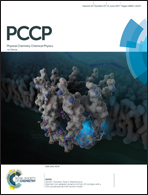A carbon nanopore model to quantify structure and kinetics of ion electrosorption with in situ small-angle X-ray scattering†
Abstract
A new carbon model derived from in situ small-angle X-ray scattering (SAXS) enables a quantitative description of the voltage-dependent arrangement and transport of ions within the nanopores of carbon-based electric double-layer capacitors. In the first step, ex situ SAXS data for nanoporous carbon-based electrodes are used to generate a three-dimensional real-space model of the nanopore structure using the concept of Gaussian random fields. This pore model is used to derive important pore size characteristics, which are cross-validated against the corresponding values from gas sorption analysis. In the second step, simulated in situ SAXS patterns are generated after filling the model pore structure with an aqueous electrolyte and rearranging the ions via a Monte Carlo simulation for different applied electrical potentials. These simulated SAXS patterns are compared with in situ SAXS patterns recorded during voltage cycling. Experiments with different cyclic voltammetry scan rates revealed a systematic time lag between ion transport processes and the applied voltage signal. Global transport into and out of nanopores was found to be faster than the accommodation of the local equilibrium arrangement in favor of sites with a high degree of confinement.



 Please wait while we load your content...
Please wait while we load your content...